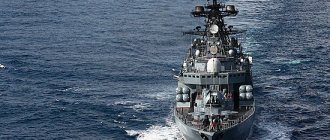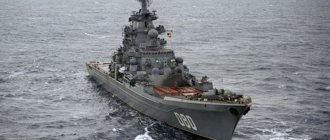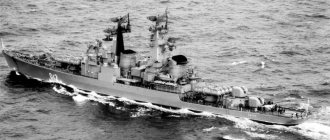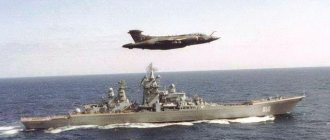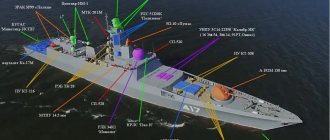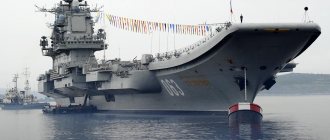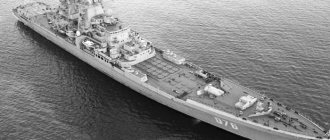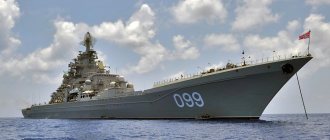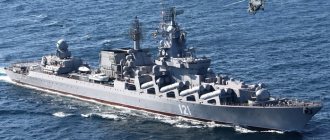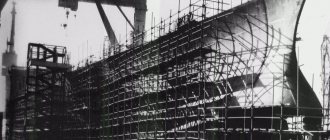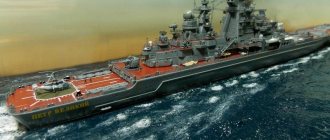In the mid-70s, the Soviet Navy began implementing an ambitious project - the construction of Project 1144 Orlan nuclear-powered cruisers, which in size and displacement are quite comparable to battleships of the Second World War. With the help of these giants, the country's leadership intended to promote state interests in the most remote corners of the globe. In fact, these ships can be called the reincarnation of battleships in the nuclear missile era. They were originally conceived as a powerful anti-submarine defense tool, but then their armament was strengthened to counter enemy surface forces.
Today, in the domestic press, the cruisers of the Orlan series are often called “aircraft carrier killers.” During the creation of this project, it was planned that in the future the TARK would be accompanied by Soviet nuclear aircraft carriers, but they were never built...
For their exceptional size and combat power, NATO has allocated heavy nuclear-powered cruisers of Project 1144 into a separate class - Kirov-class battlecruiser, which translates as “battle cruiser”. In the Soviet navy these were the only surface ships that had a nuclear power plant, and in the World Ocean the only aircraft carriers were larger than them. For example, the American Virginia-class nuclear-powered cruisers have a displacement 2.5 times less than the Orlans.
The lead ship of Project 1144 TARK "Kirov" was laid down at the Baltic Shipyard in 1974. It was accepted into the fleet in 1980. In total, four cruisers of this series were built, the last of them - TARK "Peter the Great" - was laid down in 1986 and put into operation in 1998. She is currently the flagship of the Russian Northern Fleet. The fate of the remaining “Orlans” was not so successful. "Kirov" (since 1992 "Admiral Ushakov") is currently awaiting disposal. The second ship of the TARK series "Frunze" (since 1992 "Admiral Lazorev") has been in storage for many years, and its future prospects look rather vague. The third cruiser of the Admiral Nakhimov project, which was originally called Kalinin, has been undergoing modernization since 1999. Although, in fact, work on the ship really began only in 2014. Their completion dates have been repeatedly postponed; according to the latest information from the Ministry of Defense, the modernization of Admiral Nakhimov will be completed in 2022, and in 2022 it will go into operation.
This year it is also planned to begin modernization of the nuclear-powered cruiser Peter the Great, which will last until 2022. So by this time Russia should have not one, but two powerful ships, with significantly increased combat effectiveness.
However, before telling you what exactly the cruiser “Admiral Nakhimov” will look like after completion of work, I would like to say a few words about the history of this unique project, as well as give a description of the ships of this series.
Today is the day of the steel giant
The huge warship served only a short time. Created for active confrontation with surface forces of a potential enemy, the ship was put into combat reserve six years after commissioning. This fate befell all three ships of the same type; only the last, most modern missile cruiser “Peter the Great” continued to serve in combat. In 1997, it was decided to begin repairing the ship. TARKR "Admiral Nakhimov" independently made the transition from the Northern Fleet base to Severodvinsk, where planned repair work on the ship and subsequent modernization were to begin.
Having stood near the factory wall for almost ten years, the Admiral Nakhimov TARK was awaiting a large-scale modernization. It was planned to replace the entire complex of radio-electronic equipment on the ship and prepare the ship for the installation of modern digital equipment. Back in 2008, work was accelerated, and nuclear fuel was unloaded from the reactor core on the cruiser. According to plans, the undertaken modernization of the ship was supposed to be completed in 2012, but problems that arose with the installation of weapons pushed the deadline to a later period.
The full cycle of repair work in accordance with the state program for the modernization of Project 1144.2 nuclear-powered missile cruisers began in 2013. The completion of restoration work and subsequent modernization is scheduled for 2022, after which it is planned to transfer the updated ship to the Pacific Fleet.
The glorious history of warships, alternately bearing the name of the famous Russian naval commander and Admiral Pavel Stepanovich Nakhimov, continues. More than 130 years have passed since the cold waters of the Baltic Sea touched the cheekbones of the armored cruiser Admiral Nakhimov. Today, the glorious name belongs to one of the three nuclear-powered missile ships, the most powerful surface ships in naval history.
https://youtube.com/watch?v=2kvYo2v3840
Compared to the first representative of the glorious squad of warships, the new ship has three times the displacement. The length of the ship is almost 2.5 times the hull of an old battleship. The power of the nuclear power plant is 140 thousand horsepower, which is 20 times more than the parameters of a steam engine installed on an armored cruiser. It is incorrect to compare the degree of protection and the power of weapons of ships. Despite the colossal difference, the two ships practically retained the same number of crew. On the armored cruiser of His Imperial Majesty's Fleet and on the nuclear-powered missile cruiser, 600-700 sailors must ensure combat effectiveness.
Today, the Admiral Nakhimov TARKR, which is undergoing large-scale modernization, is in the future a multifunctional ship capable of keeping vast areas and sea spaces under control.
The tragic history of ships bearing the name of the famous admiral
“Admiral Nakhimov” was not the first, and far from the last of the ships of the same name, which were literally plagued by misfortune. Many people associate these events with the name, attribute some secrets and try to find a pattern in this. But nothing like this can be traced in the history of all the “Admirals”; everything that unites them is limited only by name.
As for the destruction of ships, there is nothing mystical in it, it seems natural, although not everything is so simple, some moments simply cannot be explained.
The first, whose death subsequently gave rise to talk about a fatal pattern, was the merchant steamer Admiral Nakhimov, which in 1897 made a regular voyage to Constantinople. She was caught in a storm near the Bosphorus, and sank with a cargo of grain and the entire crew.
The next of the “unlucky ships” was the cruiser of the Black Sea Fleet “Chervona Ukraine”, which before the October Revolution was called “Admiral Nakhimov”. In November 1941, after a massive raid by enemy aircraft, while at the entrance to Tsemes Bay, it received numerous damage, and sank a few hours later.
The only one of the Nakhimovs that did not sink, but ended its days quite peacefully, was a Soviet cruiser built shortly after the war. In 1960, it was decommissioned and for some time used as a target when testing new anti-ship missiles, as a result of which it received serious damage - the bottom of the cruiser was so deformed that it could not be repaired.
For some time, secrecy was maintained around him, as a result of which many people's imagination ran wild. But again, it is difficult to draw parallels between it and the armored cruiser Admiral Nakhimov, which sank off the island of Tsushima.
But in the death of the fifth and sixth “Admirals Nakhimovs,” there really is something mysterious and unnatural. First, misfortune befell a research vessel that unexpectedly sank in 1973, sinking like a stone in front of numerous witnesses, just minutes after capsizing.
This happened in the notorious fatal bay, literally at the very pier of Novorossiysk, and half of the crew drowned along with the ship. The most tragic was the fate of the last of the sunken ships with the name of the great naval commander. Its history has no connection with the armored cruiser Admiral Nakhimov, but, strangely, the Tsemes Bay again became the site of the crash.
On the last day of August 1986, the cruise ship Admiral Nakhimov, in good visibility, collided with the bulk carrier Pyotr Vasev at Cape Doob, 13 km from the port of Novorossiysk.
At 23:20, just 8 minutes after it is not clear how the collision happened, the ship completely disappeared under water. This was a real disaster that plunged the entire Soviet people into shock - out of almost 1,000 passengers and crew members, 423 people died or went missing, including almost 100 children.
Project evaluation
Project 1144 cruisers were the first and last nuclear-powered surface missile carriers of the USSR Navy, the first large-displacement ships built after a long break, and the largest non-aircraft-carrying military ships built by any state after World War II. But with its undoubted advantages - powerful offensive weapons, high autonomy and long-range ship-based air defense systems used for the first time in Soviet practice, the ship, nevertheless, is difficult to consider completely successful.
The dimensions and cost of the Project 1144 missile cruiser are very large, while the strike functions are inferior to the cheaper Project 949 and 949A Antey missile submarines. The main function of the ship - launching missile attacks on an aircraft carrier strike group (ACG) of the US Navy - is feasible, in fact, only with a coordinated surprise attack (for example, in combination with a submarine attack on the same AUG of the US Navy). As a weapon for a possible retaliatory strike, the ship is significantly inferior to SSGNs of Project 949 and 949A due to greater visibility to the enemy and greater vulnerability.
The weak point of the basic design was its vulnerability to low-flying subsonic anti-ship missiles. Close-in air defense on the first three cruisers was represented only by the Osa-M air defense system, which had low fire performance, a relatively long reaction time and was unable to operate on targets below 25-60 meters. This was partially compensated by the large battery of the AK-630 AU, the effectiveness of which, however, was also not considered sufficient.
The unclear definition of the ship's role during the design forced the designers to equip the system with many different types of weapons, which made the ships multi-purpose, but complicated maintenance and created problems with determining the tactical and technical niche of the ship.
Ship architecture and Stealth technology
In the early eighties, the Soviet military-industrial complex was a developed industry that included thousands of enterprises and scientific institutions. The successes of domestic developers of defense systems were ensured by generous funding. When creating new models, the latest achievements in the field of offensive weapons of the military-industrial complex of potential adversary countries were taken into account. An example is the ship "Admiral Nakhimov". The cruiser was built on the principle of low visibility of its hull for radars. The outlines of the superstructures are made in the form of pyramids consisting of inclined planes, the surface part has “filled up” sides, there are practically no right angles. For painting, a special technologically impeccable substance was used, which bears the meaningless name “varnish” and does not differ in appearance from the usual ball coating of warships, but has the important unique property of absorbing high-frequency radiation, minimizing its reflection. Experts debate how effective efforts to make a 250-meter-long object low radar signature are, but the science behind it is valuable in its own right for its future applications. Indeed, such a large ship can be seen not only on radar screens, but also from a satellite, not to mention reconnaissance aircraft. Stealth technology has implications for the possible misleading of anti-ship missile guidance units. The “spot” of illumination on the screen will become smaller, and the cruiser can also project false targets using electronic missile defense systems.
Chronology
- Laid down on May 17, 1983.
- On April 25, 1986 it was launched.
- On December 30, 1988 it entered service.
- On April 22, 1992, renamed "Admiral Nakhimov".
- July 1997 - last trip to the repair site.
- On August 14, 1999, it was delivered for repair and modernization at the Sevmash plant in Severodvinsk.
- As part of the repair and modernization of the cruiser, it is planned to replace obsolete radio-electronic equipment. It is expected that modern digital systems will be installed on the ship, which will bring the cruiser’s radio electronics to the level of the 21st century.
- In 2008, the repair plan was adjusted, which made it possible to speed up modernization: the unloading of spent nuclear fuel began in September. Commissioning was planned for 2012.
- In 2012, preparatory work and design of the new appearance of the ship were completed.
- On June 13, 2013, Sevmash entered into a contract with the Russian Ministry of Defense for the repair and modernization of the cruiser. According to the terms of the agreement, the ship must enter the fleet's operational composition in 2022.
- In December 2013, work was underway on the ship to install technological support systems for repair work, as well as defect detection and unloading of equipment.
- On January 24, 2014, the Sevmash press service reported that the ship was preparing to move to the loading pool. This will be the main task for 2014. The cruiser will be raised with the help of four pontoons specially made for this purpose, to be transported over the threshold of the boatport.
- On February 4, 2014, construction of the first pontoon was completed. To launch the ship into the loading pool, 2 more additional pontoons made from blocks that were used when docking the Vikramaditya aircraft carrier will also be used. According to information as of June 4, 2014, the pontoons were installed on the dock support structure, where they are being modified. Then the dismantling of equipment on the cruiser continued.
- On July 10, 2014, the 2nd pontoon out of 4 planned for docking the cruiser was manufactured.
- On October 24, 2014, the cruiser was launched into the Sevmash loading basin.
- January 30, 2015 - the cruiser is prepared for fire work, dismantling of the ship's internal hull structures continues.
- November 2, 2015 - dismantling of the old equipment was completed. The ship is preparing to receive new equipment.
- February 2016 - defect detection of the hull structure was completed at Sevmash and priming work began.
- According to the Russian Navy, the planned repairs of the nuclear-powered cruiser Admiral Nakhimov should be completed by 2022.
Modernization goals
The main goal of the expensive work is to give the combat unit of the Northern Fleet the desired combat effectiveness. This requires not only a complete replacement of equipment and weapons systems that have become obsolete since 1980, but also ensuring the possibility of further modernization in accordance with the requirements of the coming decades. Electronic equipment, missiles and control systems lose relevance quite quickly, and the mistakes of the designers who built the cruiser Admiral Nakhimov in the eighties should not be repeated. Modernization, inevitable in a few years, should be less painful and cost much less.
Among the most labor-intensive tasks assigned to Sevmash shipbuilders, in first place is the replacement of inclined silo launchers intended for 3M45 missiles with universal UKSK 3S14 vertical launch complexes. Perhaps the inclined design will still not be abandoned (many details of the project are kept secret), but the launch will no longer be carried out from flooded positions (the need for this was dictated by the “submarine” origin of the obsolete 3M45). There were 20 mines in total, the same number will remain, but each of them will house a modular system with four missiles. In total, the number of anti-ship missiles will increase fourfold and amount to 80.
What they will be like is anyone’s guess, most likely “Onyx” or “Turquoise”. The cruiser's reputation as an "aircraft carrier killer" suggests the possibility of equipping strike weapons with special charges (nuclear). Such a large number of missiles in Nakhimov’s arsenal is dictated by the “swarm” method of their use. It is almost impossible to repel a group attack by anti-ship missiles.
In addition to the main caliber, the TARK will presumably be armed with 3M14 subsonic weapons intended for ground-based coastal targets. The crew will fight against submarines with the Package-NK complexes (it is possible that the well-proven and not outdated Vodopad-NK will be retained as part of the armament). RBU-6000 rocket launchers will replace "Boas-1", capable of providing reliable protection against torpedo attacks.
Design
Hull and superstructure design
The ship has about 1,600 rooms, including 140 one-, two- and four-berth cabins for officers and midshipmen, more than 32 cabins for sailors and petty officers (for 8-34 people each), corridors, gangways and vestibules with a total length of almost 20 kilometers , more than 30 showers, two baths, one sauna with a 4x3 m swimming pool, a two-tier medical block with isolation hospitals, a pharmacy, an X-ray room, an outpatient clinic, a dental office and an operating room. The power plant of the Project 1144 cruiser could theoretically provide electricity and heat to a city with a population of more than 150 thousand inhabitants.
Basic tactical and technical elements
Displacement
- Standard: 23,750 t
- Full: 25,860 t
Dimensions
- Maximum length: 250.1 m
- Maximum width: 28.5 m
- Draft overall: 10.3 m
Travel speed
- Full - 31 knots (more than 55 km/h)
- Operational and economic - 18 knots (more than 33 km/h)
- Navigation autonomy: 60 days
Crew
759 people (including 120 officers)
Power plant
Heavy nuclear missile cruiser "Frunze"
Nuclear power plant with KN-3 reactors (English)Russian. (VM-16 type core), although created on the basis of OK-900 type icebreaker reactors (English) Russian, has significant differences. The most important thing is that the fuel assemblies (manufactured by the machine-building plant in the city of Elektrostal) contain uranium with a high degree of enrichment (about 70%). The service life of such a zone until the next recharge is 10-11 years. Reactors are double-circuit, water-water, thermal neutron. High-purity water (bidistillate) is used as a moderator and coolant, which circulates through the reactor core under high pressure (about 200 atmospheres), ensuring boiling of the secondary circuit, which goes to the turbines in the form of steam.
Particular attention was paid to developing a scheme for using the ship's power plant, the shaft power of which reached 70 thousand hp. With
The complex-automated nuclear power plant is located in three compartments and includes two nuclear reactors with a total thermal power of 342 MW, two turbo-gear units (located forward and aft of the reactor compartment) and two backup automated KVG-2 boilers installed in the turbine compartments. The steam supply system allows you to supply steam to any installation on any side. Main parameters of the boiler unit: temperature of superheated steam at a pressure of 66 kg/cm² - 470 degrees Celsius, boiler efficiency up to 84%, dry boiler weight 50 tons. Steam capacity is 115 t/hour.
The cruiser's power plant includes four 3 MW steam turbine generators and four 1.5 MW gas turbine generators produced by the Proletarsky Plant, located in four autonomous compartments. The motor life of each of them is up to 50 thousand hours.
The fiery sky of the Russian fleet
Without effective and strong naval aviation there can be no modern Navy
One of the most serious comments made to the author regarding the previous two articles (“Russian Navy ran into mines and submarines”, “NVO” from 11.22.18 and “Russian Navy is being deprived of ocean status”, “NVO” from 11.30.18) was the undisclosed role and the importance of aviation in naval theaters of operations - a factor that has become decisive for the appearance of all fleets since the Second World War. Previously, the author has already touched upon this issue in a number of publications, which examined various aspects of the use of naval aviation, including history, and today we will talk about the current state and prospects for development.
White elephants of the fleet
The Project 1144 Orlan heavy nuclear-powered missile cruisers are one of the visible symbols of the USSR Navy and at the same time a good example of what comes out of long red tape when developing and refining technical projects. The first approaches to the projectile began at the turn of the 1950s and 1960s, the lead ship was laid down in 1973, and was delivered to the fleet only in December 1980.
From the idea of creating a large anti-submarine ship with a nuclear reactor and a displacement of 8 thousand tons, two branches first grew (a nuclear-powered anti-submarine cruiser and a nuclear-powered cruiser with anti-ship weapons), then they were combined. The resulting multi-purpose monster with a displacement of over 25 thousand tons, still characterized in the West as a battle cruiser, with all its undeniable combat capabilities, turned into a warehouse for new weapon systems and electronic weapons for the fleet - with a concomitant increase in the complexity and cost of construction.
The USSR was able to introduce only three ships of this type: the lead “Kirov” (1980), “Frunze” (1984) and “Kalinin” (1988). The unfinished Yuri Andropov was inherited by the Russian Federation, which handed it over to the fleet in 1998 under the name Peter the Great.
Cruiser_1
Heavy nuclear missile cruiser "Admiral Lazarev" and floating workshop PM 74 (from left to right)
Photo: TASS/Vladimir Sayapin
By this time, the remaining ships were renamed, respectively, “Admiral Ushakov” (in 2004 the name was taken away and what remained was a formally nameless ship with tail number 090 and the letters “Kirov” missing), “Admiral Lazarev” and “Admiral Nakhimov”.
The cruiser's armament was based on 20 inclined launch silos of the Granit anti-ship missile system (range up to 600 km). Anti-aircraft weapons included the long-range S-300F Fort air defense system and the Osa-M self-defense air defense system (on the first three ships). On the Petra, instead of the S-300F, they installed the S-300FM Fort-M, and instead of the Osa, they installed the more modern Kinzhal. On Kalinin and Petra, the 30-mm AK-630 assault rifles were replaced with six Kortik short-range anti-aircraft missile and artillery systems. The composition of anti-submarine weapons and electronic weapons changed from ship to ship.
Modernization opportunities
Over the past almost three decades, almost all of the ship's technical equipment and weapons systems have become outdated, and now only a huge hull equipped with a powerful nuclear power plant is of value to the fleet. However, the cost of this “platform” is such that it should not be neglected. An example of careful treatment of expensive equipment is the American Navy. All large-tonnage US ships are initially built with possible modernization in mind; power supply cable channels and installation dimensions are made in such a way that replacing any equipment - in the event of a more modern one - is not a problem. The repair of the cruiser Admiral Nakhimov, which formally began in 1998, was delayed precisely because there was a need for a huge number of design changes necessary for effective modernization. TARK "Kalinin" (under this name the ship was laid down in 1983 and served until 1993) could not satisfy the conditions of naval combat at the beginning of the third millennium. The restructuring project was entrusted to the Northern Design Bureau (St. Petersburg), and 21 months were allocated for its development. The documentation estimate amounted to almost 2.8 billion rubles. It is expected that the entire modernization of the ship will cost tens of billions. There were immediately critics who argued that for that kind of money it was possible to build several new combat units of the frigate or corvette class, which together had greater combat capabilities. This opinion, of course, has a right to exist, but light class ships are not designed to perform the tasks for which the Admiral Nakhimov was built. The cruiser has a larger operational radius and lasts much longer than a destroyer or BOD, so in general its modernization is economically justified.
Additional weapons
General ship-wide countermeasures include two twin 150-mm PK-16 launchers (a complex of projectile jammers), anti-electronic decoys, decoys, as well as a towed decoy torpedo target with a powerful noise generator. The cruiser also has three navigation stations, four radio-electronic fire control systems for on-board weapons, helicopter flight controls and a “friend or foe” identification system.
The take-off deck at the stern of the cruiser Kalinin. Open hangar doors and deck helicopters Ka-25 and Ka-27 are visible
Each cruiser of Project 1144 is based on two heavy multi-purpose Ka-27 helicopters in the RLD and PL modifications. The helicopters are used in the anti-submarine version and as a relay-flight spotter for the Granit anti-ship missile system. The helicopter crew is 3 people (pilot, navigator and sonar operator). Maximum take-off weight - 11 tons, flight duration - 4.5 hours, ceiling - 4300 m, maximum speed - 270 km/h, flight range - 800 km. Helicopters can have APR-2E anti-submarine missiles (diameter - 350 mm, length - 370 cm) with a solid-fuel rocket engine that provides a speed of 115 km/h under water. Rocket weight - 575 kg, b/h - 100 kg. Underwater, the missile moves for 2 minutes, surveying a space with a radius of 1500 m and determining the bearing of the target with an accuracy of 2°. The helicopters are also armed with guided depth charges weighing 94 kg and moving at a speed of 55 km/h with an active hydroacoustic guidance system. The onboard radio-electronic complex of the Ka-27 helicopter ensures flight over the sea in any weather, search and tracking of submarines at a distance of up to 200 km from the ship, automatic launch of the helicopter to the point of release of weapons, return and landing in automatic mode.
The sonar system includes a sonar with a hull antenna (in a bulb fairing) for searching and detecting submarines at low and medium frequencies and a towed automated sonar system with an antenna of variable immersion depth (150-200 m) at medium frequencies.
Differences from the lead ship[edit]
Aerial view of the bow of the Kalinin,
illustrating the differences from the lead ship of this class.
2 SADS-N-1 anti-aircraft missile systems
2 x retractable (lower-down) SA-N-4 anti-aircraft missile (SAM) launchers (one visible)
20 launchers of SS-N-19 cruise missiles
12 launchers of anti-aircraft missiles (SAM) SA-N-6
space for 8 SA-N-9 air defense systems (not installed)
Kalinin
was built differently than the lead ship of this class.
On the bow of the ship, the twin SS-N-14 anti-submarine launchers were replaced by eight SA-N-9 vertical SAM launchers (not installed). The advanced 30 mm CIWS cannons were replaced by the SAPR-N-1. At the rear, instead of two 100 mm guns, a single twin 130 mm AK-130 gun was used, similar to the guns on Slava
and
Sovremenny
. Near the flight deck, the 30 mm CIWS cannons were replaced with Kashtan CIWS and moved to the aft superstructure and replaced by eight SA-N-9 vertical launchers (not installed).
Current status
According to Deputy Minister of Defense of the Russian Federation Vladimir Popovkin, the Ministry of Defense of the Russian Federation has developed a program for the restoration of heavy nuclear-powered missile cruisers. As of September 2009, the Russian Navy had one nuclear-powered missile cruiser, the Peter the Great, in service, and the possibility of restoring and modernizing the nuclear-powered cruiser Admiral Nakhimov, as well as the Admiral Lazarev, was discussed. “We have several such ships left from the Soviet fleet. We have developed a program to restore them,” Popovkin said. According to him, the Russian Ministry of Defense considers it expedient to have up to three such ships in the Navy, despite the fact that one of them will be in the Pacific Fleet and two in the Northern Fleet. The need to use heavy nuclear-powered missile cruisers is dictated by the tasks of long-distance cruises and exercises, the Deputy Minister explained.
According to a high-ranking representative of the General Staff of the Navy: “All nuclear-powered missile cruisers of Project 1144 in reserve will be returned to the operational strength of the Russian Navy by 2022.” The work will be carried out over the next five years. Then the Admiral Nakhimov will go to the Northern Fleet.
During the ongoing repair of the heavy nuclear missile cruiser "Admiral Nakhimov", P-800 "Oniks" anti-ship missiles were installed instead of the previously installed P-700 "Granit" anti-ship missiles. Launching is scheduled for 2018. According to unconfirmed reports, the cruiser “Peter the Great” will also undergo a similar modernization. The remaining two cruisers of Project 1144 will most likely be finally scrapped.
The future according to the military
The heavy nuclear-powered missile cruiser "Peter the Great" will undergo repairs and deep modernization in 2018-2021, after completion of work on the same type "Admiral Nakhimov", the decision to modernize the cruiser "Admiral Lazarev" has not yet been made. TASS reports this with reference to a source in the Main Staff of the Russian Navy.
“Its renovation and modernization is planned to be completed in 2022. Thus, in 2022, the Navy will have two practically new nuclear cruisers, the combat effectiveness of which will increase by one and a half to two times,” the agency’s interlocutor said.
The source clarified that both ships will remain in the North and they will be part of the Joint Strategic Command in the Arctic. According to him, both cruisers will have their weapons, radio and electronic equipment, life support systems, internal structures, pipelines and fittings replaced. The ships' nuclear reactors will not be changed, but the systems that ensure their constant operation will definitely be replaced.
According to a number of assumptions previously made by experts, the Project 1144 Orlan cruisers, during modernization, will be armed with the Onyx and Kalibr strike missile systems (the latter includes cruise missiles for high-precision strikes against ground targets), as well as a new anti-aircraft missile complex "Poliment-Redut".
The fate of the third cruiser of Project 1144 (“Admiral Lazarev”), according to the agency’s interlocutor, is still unknown. “The decision on whether it will be modernized or sent for disposal, like the lead ship of the Admiral Ushakov series, has not yet been made,” he said, noting that if they still decide to keep it, then after modernization it will be sent to serve to the Pacific Fleet.
The cruiser "Admiral Nakhimov" has been in storage since 1999 (officially - "under repair"). Work on the cruiser began only in the fall of 2014. The ship should be repaired and modernized at the Severodvinsk Sevmash in 2015-2018.
The lead ship of the series (Admiral Ushakov, until 1992 - Kirov), which has been laid up since 1991 due to serious problems with the power plant, will be sent for disposal in 2016.
Is modernization of the Admiral Nakhimov TARKR worth the money?
In the previous article, we compared the capabilities of the modernized Nakhimov TARKR and three frigates, which could probably be built with the money spent on modernizing the giant nuclear cruiser. The conclusions can be briefly summarized as follows.
Compared to the three TARKR frigates, the Admiral Nakhimov is a real floating arsenal. The thing is that the cruiser will have 80 UKSK cells, 92 (probably) S-300FM air defense missile silos and 20 533-mm torpedoes or Vodopad PLUR. In other words, the ammunition load of the TARKR includes 192 cruise and anti-ship missiles, heavy missiles and anti-ship missiles, while the three frigates of Project 22350 can only carry 48 such ammunition in UKSK installations (according to the website of the Almaz-Antey Corporation, UKSK can be used for the use of heavy missiles). At the same time, the ammunition load of the Redut air defense system, and it will most likely be installed on the TARKR, will most likely correspond to that on all three frigates of the Admiral of the Fleet of the Soviet Union Gorshkov class.
As for the missile guidance channels, taking into account the possible modernization of the control radar of the S-300FN air defense system, it can be assumed that the TARKR will have an advantage over 3 frigates when repelling an attack from one side, is approximately equivalent to them when attacking from two directions and will be inferior to them, if the attack takes place from different 3-4 sectors. The anti-submarine capabilities of three frigates will probably still be higher due to the fact that there are three of them and they can cover a larger water area. But the TARKR sonar system is most likely still individually more powerful, the number of helicopters is the same, while the cruiser still has preference as an “airfield” - if only due to its lesser susceptibility to pitching.
But three frigates of Project 22350 are an approximate equivalent to the cost of the serial MAPL Project 885 Yasen-M. Perhaps it would have made sense, instead of modernizing the TARKR, to order the industry another modern nuclear-powered submarine?
It must be said that while a direct comparison of the tactical and technical characteristics of TARKR with 3 frigates still makes some sense, then a similar comparison of a surface ship with an underwater ship, apparently, does not. Yes, these ships may be assigned the same tasks, for example, searching for and destroying enemy submarines, or a missile attack on a group of enemy surface ships, but the methods for performing them will be very different. Therefore, below we will look at some of the main tasks that can be solved by the fleet in peacetime and wartime, and how 3 frigates, a TARKR or a multi-purpose nuclear submarine can cope with them.
Flag display
Of course, a giant nuclear-powered cruiser will be much more impressive than one or two frigates.
On the other hand, having three frigates guarantees that at least one of them will always be on the move, more often there will be two, and sometimes all three. In other words, the TARKR is more visible and “weightier”, but still must periodically undergo routine and medium repairs, and it may turn out that at the right time it will not be operational, but this will not happen with frigates. In addition, TARKR is atomic, that is, it may not enter all ports, and this may also impose certain restrictions. As for the MAPL, it is of little use for displaying the flag and, as a rule, is not used.
Projection of force
Here we are talking about exerting political pressure by military means, and for this all three types of ships are equally suitable. Let us only note that TARKR, being a large ocean-going ship with much greater autonomy than a frigate, is better suited for performing this task in long-distance sea and ocean zones. At the same time, MAPL, like the Yasen-M, is limited in its effectiveness in solving this problem, for the simple reason that an undetected nuclear submarine poses a real danger to the navy of a potential enemy. But if a nuclear submarine is not detected, then the threat from it is not felt, and if it makes itself known, it turns from hunter to game.
On the other hand, there are a number of specific situations when MAPL will have preference. For example, the NATO Navy did not like it very much when our “Pike” surfaced in the area of their anti-submarine exercises, the presence of which was not known until it specifically unmasked itself. And our submariners serving on SSBNs were clearly not too pleased to hear when, during training for the launch of ballistic missiles, the covers of the torpedo tubes of a foreign submarine were opened.
Combat service
By it, the author means a projection of force, in the implementation of which there is a possibility of its real use.
In other words, this is a situation in which our warship accompanies the target in readiness for its immediate destruction - upon receipt of the order, of course. In most cases, when solving such a problem, TARKR will have an advantage over both frigates and a nuclear submarine. Consider, for example, the classic case of tracking the US AUG - and at least in the same Mediterranean Sea. Of course, if you look at the globe, this sea looks very small in comparison with the endless expanses of the Atlantic, Pacific or Indian Ocean. But in fact, the Mediterranean is very, very large - for example, the distance from Malta to Crete is about 500 miles, and in order to get from Gibraltar to Turkish Izmir you will have to travel about 2,000 miles. Of course, the cruising range of the Project 22350 frigate is much greater, amounting to 4,500 miles. But the fact is that a frigate can cover such a distance only by traveling at an economical speed of 14 knots, and if it needs to go faster, the cruising range will drop sharply. At the same time, the American destroyer Arleigh Burke, having a range of 6,000 miles at 18 knots, will naturally be able to travel a much greater distance at high speed than the Admiral Gorshkov. The Project 22350 frigate is quite capable of accompanying a single Arleigh Burke or a group of such destroyers, or even a full-fledged AUG, traveling at high speed for some time, but then its fuel reserves will simply begin to run out, so it will have to stop the pursuit.
In other words, if the Americans plan to strike first, they may well, having undertaken a series of energetic maneuvers and moving for a long time at a speed of 25 knots or more, break away from the tracking of our frigates and, at the moment the attack begins, get out from under the “cap” of Soviet ships. But with TARKR, for obvious reasons, such a “number” will not work in any case: its nuclear power system is capable of providing the ship with maximum speed for an almost unlimited time.
In principle, a multi-purpose nuclear submarine, having an equally unlimited range, in theory can also control the movement of enemy ships. But in this case, the problem of concealment of movements arises for the submarine. The fact is that the 3rd generation nuclear submarines were relatively quiet only at speeds of 6-7 knots (approximately), for the 4th generation nuclear submarines, that is, Seawolf, Virginia and Yasen-M, this figure was increased up to approximately 20 knots, but still, a squadron of surface ships can move much faster for some time. Accordingly, the submarine controlling their movement will also have to make a big move and thereby unmask itself. This may not be decisive if our ship receives the order to use weapons first. But if the Americans receive such an order, the nuclear submarine will have almost no chance to strike; with the highest degree of probability, they will have time to destroy it before using weapons.
During the Cold War, our sailors often used this method - since the routes for the advance of SSBNs from bases to combat training areas were well known to the command, anti-submarine aircraft took to the air, placing a line of sonobuoys along the route, or a multi-purpose SSBN was “ambushed” on the way Submarine. As a result of such actions, American nuclear submarines were often identified that followed our “strategists” - even despite the best low-noise indicators of the atomic submarines of our “sworn friends”. And if suddenly the leadership of the USSR at some point decided to launch a preventive nuclear strike, then the American “hunters” could well be destroyed before they managed to cause harm to the SSBNs entering the positions. Alas, the same is true for our MAPLs tracking the AUG.
TARKR will have an advantage here due to its significantly greater combat stability. “Taking down” a surface ship with a displacement of 25 thousand tons is far from a trivial task, even if there is a first strike advantage. Here, even tactical nuclear weapons do not guarantee success (it is possible that the munition with nuclear warheads will be shot down). So, with a high degree of probability, TARKR, even being attacked and dying, will still be able to deliver a fatal blow to the aircraft carrier of our “sworn friends.”
Covering SSBN deployment areas
Very often one comes across the point of view that such cover is completely unnecessary: they say, the presence of surface or submarine ships or aircraft guarding our underwater strategic missile carriers only unmasks the latter.
One should unconditionally... agree with this point of view. As was absolutely rightly noted by a number of respected “members of the VO commonwealth,” SSBNs are not a flock of sheep, and MAPLs or other warships are not shepherds, and such use of them can really unmask strategic submarine missile carriers. Nevertheless, it is necessary to cover SSBN deployment areas, but this is done in other ways.
The easiest way would be to draw this analogy. For a long time during the Second World War, the anti-submarine defense of the British was reduced to improving the protection of convoys of transport ships - they were assigned a larger number of anti-submarine ships, later escort aircraft carriers began to be included in the convoys, etc. But at the same time, as military production in England and the United States grew, starting in 1942, so-called “support groups” began to form. They were separate detachments consisting of patrol ships, frigates and destroyers, whose task was to freely hunt German submarines. In other words, these hunting groups were not burdened with the responsibility of protecting this or that slow-moving caravan, but had to independently, and in cooperation with carrier-based and base aviation, search for and destroy enemy submarines.
So, approximately, our SSBN cover should be built, which does not consist at all in the fact that we will attach several nuclear submarines and surface ships to each missile carrier, but in the fact that we must be able to clear the Barents and Okhotsk Seas of anti-submarine aircraft and submarines of our potential enemies. This will also provide cover for the SSBN.
To solve this problem, depending on the area and other conditions, frigates will be needed in some places, nuclear submarines and diesel-electric submarines in others, and in general the joint efforts of aviation, surface and submarine ships will be required. According to the author, frigates and the Yasen-M MAPL will be the most effective for solving this problem, but the TARKR is still too large and over-armed for such work. It is simply not optimal for such problems, although it can, of course, take part in solving it. Even before its modernization, TARKR had all the advantages of the Project 1155 BOD, which had the same Polynom hydroacoustic complex and 2 helicopters, but at the same time it also had long-range missiles capable of significantly annoying anti-submarine aircraft.
Participation in a global conflict
In the event of a global conflict, the most dangerous surface enemy of our fleet will be US carrier strike groups.
Alas, the capabilities of our surface ships to resist them are extremely limited. In essence, more or less acceptable chances of destroying an AUG by a missile strike from TARKR or frigates are achieved only from the position of tracking it in peacetime. That is, if at the start of the war our ships control the location of the AUG and manage to use their strike missile arsenal, then with the highest degree of probability the US aircraft carrier will be destroyed, or at least completely lose its combat effectiveness. If the TARKR, which is armed with hypersonic anti-ship missiles, is used in this way, most likely the aircraft carrier will be destroyed along with the escort ships.
But in all other situations, there will be very little chance of hitting the AUG on surface ships - either TARKR or frigates. The Americans will not necessarily need to go to our shores; they may well achieve the goals they need by placing aircraft carriers off the coast of Norway and Turkey, in the Norwegian and Mediterranean Seas, without entering the Black or Barents Seas. It will be extremely difficult to reach them there by surface ships.
Soviet missile cruisers and destroyers, for all their advantages, had two fundamental disadvantages. Firstly, the flight range of anti-ship missiles, even heavy ones, was usually less than the range of American carrier-based aircraft, so Soviet surface ships would have to spend many hours approaching under the threat of destruction from the air. The second is the lack of reliable target designation means for over-the-horizon firing of anti-ship missiles, and not even for missile cruisers, but for the USSR Navy in principle.
Unfortunately, the range of hypersonic Zircons in the anti-ship missile version is currently unknown. But even if we assume that it is 1000 km, and this is extremely doubtful, then the problem of obtaining target designation still remains. Detection, identification and escort of enemy ships located in the enemy’s zone of absolute air dominance is today an extremely difficult, if not solvable, task. Theoretically, in the absence of an appropriate aviation deck, this could be done using satellites or over-the-horizon radars, but we are chronically short of the former, and the latter require additional reconnaissance.
Of course, an underwater ship will face the same difficulties as a surface ship, but MAPL will have advantages due to its stealth: despite all the modern means of detecting underwater ships, they still, in this parameter, have a significant advantage over surface ships. At the same time, one should not expect miracles from a single submarine.
Today, the US carrier strike group is clearly the top of the “food pyramid” at sea. This does not mean at all that the AUG cannot be defeated, but this requires a developed system of naval reconnaissance and target designation, as well as the joint efforts of well-trained and fairly numerous heterogeneous forces, including surface and submarine ships and aircraft. Due to the massive reduction in the number of naval personnel and naval aviation, unfortunately, we have none of this today, and neither a single TARKR or Yasen-M, nor a trio of frigates can correct this situation.
And again, all of the above does not mean that these forces will be completely useless for us. In certain circumstances, thanks to the competent actions of the commanders and the professionalism of the crews, it will be possible to achieve success even with obviously weaker forces. Thus, during the Anglo-American exercises of 1981, the British destroyer Glamorgan under the flag of S. Woodward managed undetected to get close to the “heart” of the American warrant - the aircraft carrier Coral Sea and “hit” it with a salvo of anti-ship Exocets from a distance of only 11 nautical miles. Despite all the escort ships, 80 attack and reconnaissance aircraft of the air wing, including AWACS aircraft.
"Trophy" of Admiral S. Woodward - aircraft carrier "Coral Sea"
However, we must not forget that S. Woodward, in addition to the Glamorgan, had at his disposal 3 more frigates and 3 auxiliary vessels, which he used to “attack” the AUG from various sides. Despite the fact that the attack began from 250 miles (hardly in a real combat situation British ships would have been “allowed” to come so close to the AUG) and the undoubtedly high professionalism of the British sailors, out of 7 ships and vessels involved in the attack, luck smiled on only one .
In general, we can state the following: in terms of confrontation with the US AUG, the chances of the above-mentioned ships are low, but, probably, those of the Yasen M are still higher, followed by TARKR and in last place are the three frigates.
Local conflicts
However, you need to understand that global war is not the only form of conflict for which the Russian Navy should prepare.
The USSR, and subsequently the Russian Federation, previously had and still has today the United States and NATO as their main geopolitical adversaries. However, we had to fight in Afghanistan, Chechnya, Georgia, Syria... In other words, we should not ignore the possibility of our fleet participating in some local conflicts, like what happened among the British and Argentines in 1982 for the Falkland Islands. So, oddly enough, in conflicts of this kind, a modernized TARKR can prove to be much better than a multi-purpose nuclear submarine. This thesis is perfectly illustrated by the experience of the British in their war for the Falkland Islands, where British nuclear submarines demonstrated literally blatant uselessness.
Let us briefly recall how events developed. After the capture of the Falkland Islands by Argentina, the British, having decided to resolve the conflict by force, had to solve 3 problems:
1. Establish supremacy at sea and in the air in the area of disputed territories.
2. Ensure landing of the required number of troops.
3. Defeat and force the surrender of the Argentine ground forces that captured the Falkland Islands.
Frankly speaking, the British had little strength for this. Argentina could use about 113 combat aircraft against the British squadron, of which 80 Mirages, Daggers, Super Etandars and Skyhawks had real combat value. At the beginning of the operation, the British had as many as 20 Sea Harriers FRS.1, the only advantage of which was that they were located on two aircraft carriers, which could, at the request of the commander, approach the Falkland Islands as close as desired, while the Argentine pilots it was necessary to operate from the mainland, and almost to the maximum radius of action. However, this did not apply to the air group of the only Argentine aircraft carrier.
In other words, the Royal Navy did not have anything even remotely resembling air superiority. It also did not have a noticeable superiority in surface forces, because, not counting aircraft carriers, the Argentine fleet had 8 surface ships, including a light cruiser, 4 destroyers and 3 corvettes, and the British had 9 ships of the “destroyer” or “frigate” class " The number of cruise missile launchers for the British and Argentines was the same, 20 each, and both used Exocet anti-ship missiles.
In other words, it turned out that the Argentines had an advantage in the air, and an approximate equality in strength over water. Thus, the only “trump card” of the Royal Navy remained submarines, in which the British had absolute superiority: three British nuclear submarines could be countered by a single diesel submarine (German project 209) San Luis.
I would like to note that of the three British nuclear submarines, two - Spartan and Splendite - belonged to the Swiftsure class and were the most modern ships that entered the fleet in 1979 and 1981, respectively.
Nuclear submarine "Spartan"
These were nuclear submarines of moderate displacement 4,400/4,900 tons (standard/underwater), with a crew of 116 people, and armed with 5 * 533-mm torpedo tubes with 20 units of ammunition, which, in addition to torpedoes and mines, could also include cruise missiles "Sub-Harpoon" or "Tomahawk". Although, apparently, they did not carry missiles during the Falklands conflict. When submerged, nuclear submarines could reach speeds of up to 30 knots, but their main advantage was the use of water-jet propulsion instead of classic propellers, which made it possible to seriously reduce their noise level. The third atomic submarine, Concerror, although it belonged to the previous type of Churchill nuclear submarine, as of 1982 it was also a completely modern warship.
What were these three British submarines supposed to do? The Argentine fleet's plan was quite simple - in anticipation of the British attack, it went to sea, deploying three tactical groups, and was ready to attack as soon as the British began landing. Thus, British submariners were supposed to intercept these groups in the 400-mile gap between the coast of Argentina and the Falkland Islands and destroy as many Argentine ships as possible.
What did the British nuclear submarines achieve? Of the three tactical groups, the British were unable to find a single one. Yes, Concerror managed to make contact with TG-79.3, consisting of the light cruiser Admiral Belgrano and two destroyers, but the location of the Argentine detachment was suggested to her by United States space intelligence. Of course, it was not too difficult for a modern atomic marine to escort three military-built warships that did not have modern acoustic equipment, and to sink the Belgrano when such an order was received. But the dark humor of the situation lies in the fact that the Argentines assigned TG-79.3 purely demonstration tasks: in other words, this group was supposed to divert the attention of the British, while the carrier-based aircraft of the only Argentine aircraft carrier, together with land-based aircraft and the San Luis "would deal the main blow. And even the British submariners managed to discover the demonstration group only with a tip from the Americans!
At the same time, the Splendid and Spartan, deployed to the north, were unable to detect the main forces of the Argentine fleet and they did not cause any damage to it. The result is all the more sad because the Splendid received information about the contact of the British Sea Harrier with the Argentine destroyer Santisimo Trinidad, which, together with its sistership Hercules and the aircraft carrier Veintisinco de Mayo, formed the tactical group TG-79.1 .
Subsequently, all three Atomarines were sent to the coast of Argentina, in the hope of finding enemy warships there, but nothing came of this venture. They were unable to detect anyone, but one of the nuclear submarines itself was discovered and attacked by Argentine aircraft, and they were recalled, assigning them patrol areas in the immediate vicinity of the Falkland Islands.
This is not known for certain, but it seems that only poor-quality ammunition saved the British from a heavy and extremely offensive loss. The fact is that on May 8, an Argentine submarine spotted an unknown target moving at a speed of 8 knots and attacked it with an anti-submarine torpedo. The acoustician recorded the sound of metal hitting metal, but there was no explosion. Most likely, the San Luis torpedoed the newest British Splendid, because there were no other British ships in the area, and besides, according to some sources, the Splendid left the combat area immediately after that. Although, of course, the Argentine sailors may have imagined all this - in war there are other things that don’t happen.
In other words, the Royal Navy’s atomic ships were unable to defeat the enemy’s surface forces, were unable to provide anti-aircraft defense to the British formation, neutralizing the San Luis, and the newest Splendid may have almost become a victim of the Argentine submarine. The British tried to use them as VNOS posts, that is, air surveillance, warning and communications. The idea was for the British atomic submarines to surface in close proximity to the airfields where Argentine aviation was based and visually track strike air groups heading towards the Falklands... naturally, nothing good could come from such an extravagant use of nuclear submarines. At the same time, the British forces, not being able to establish air superiority over the area of operation, experienced an extreme lack of modern air defense systems to repel Argentine raids. Their atomics, of course, could not help with this.
Of course, the best option for strengthening the British naval group would be a catapult aircraft carrier carrying classic carrier-based aircraft (not VTOL aircraft). But, if the British had a choice between one additional Yasen M nuclear submarine, or three Project 22350 frigates, or the modernized Admiral Nakhimov TARKR, then the British commander would most certainly prefer a nuclear-powered cruiser or frigates.
It can be assumed that in an operation similar to the Falklands conflict, it would be the nuclear cruiser that would be most useful - due to the large ammunition load, which would be enough not only to destroy the Argentine fleet, but also to attack ground targets with cruise missiles, as well as high combat stability - to withdraw it is very difficult for a ship like TARKR to be damaged by free-falling bombs or even Exocet anti-ship missiles. According to some reports, our TARKRs were supposed to withstand up to 10 hits from Harpoons, while maintaining combat effectiveness. In addition, TARKR would be ideal for the role of leader of an air defense order, since it has sufficient capabilities to quickly coordinate the actions of a group of warships.
From all of the above, we can draw the following conclusion. The return to service of the “Admiral Nakhimov” with the subsequent modernization of the “Peter the Great” in his “image and likeness” is an absolute benefit for our fleet, and one can only regret that the “Admiral Lazarev” could not be saved. The price for the revived TARKR - three frigates of Project 22350 or one MAPL "Yasen-M" does not look excessive, because it has its own tactical niche, tasks that it can cope with better than frigates or MAPL.
In the event of a threat of a global conflict, such a ship as part of the Northern Fleet could go into combat service in the Mediterranean Sea, where a salvo of 80 Zircons, if successful, could inflict decisive losses on the US 6th Fleet. In the Pacific Ocean, such a ship, operating under the cover of ground-based aviation, would pose a noticeable threat to the AUG wishing to strike our Far Eastern targets and would seriously complicate their actions. In a local conflict, TARKR is capable of being the flagship and real “fulcrum” of a small ship group (we simply cannot assemble a large one), because, with rare exceptions, third world countries do not have the means and/or sufficient professionalism to destroy a ship of this class . And, of course, the St. Andrew’s flag above a twenty-five thousand-ton steel giant, bristling with radars, missiles and artillery pieces, and capable of single-handedly dealing with the navy of other regional powers, looks... proud.
So maybe the idea of building nuclear destroyers of the Leader type is not so divorced from reality?
Alas, this is just extremely doubtful. The fact is that when modernizing the TARKR from the era of the Soviet Union, we use ready-made huge buildings, and also retain the existing nuclear power plant. In this case, we are talking not only about the reactor, but, as far as the author knows, also about turbines, shafts, etc. - all this makes up a significant portion of the cost of a nuclear warship. It is known that on the Arleigh Burke destroyers, the cost of the hull together with the chassis is about 30% of the total cost of the ship, the rest is weapon systems, radars, BIUS, etc. But nuclear power systems are much more expensive, and it can be assumed that in the case of domestic “Leaders” the indicated costs will be related as 50 to 50. In turn, this suggests that the real cost of a domestic nuclear “destroyer” of 20 thousand tons with a displacement may well turn out to be comparable to six Project 22350 frigates or two multi-purpose nuclear submarines, and this is a completely different arithmetic...
“They get used to the ship and love it like a child.” About how the “Ash” and “Borey” are built by the Russian Navy
TASS - about some unique technologies used in the construction of nuclear submarines, and about the capabilities of the country's largest shipyard
A bottle of champagne was broken on a giant hull, the crew sang the Russian Anthem, and a state-of-the-art submarine was taken out of the boathouse of Russia’s largest shipyard, Sevmash. On the slipway train, the boat will first be taken to the dock of the loading pool, and then released into its native environment. It will be weeks and months before the Yasen or Borei meet the White Sea - American satellites will certainly film their arrival. This never goes unnoticed.
